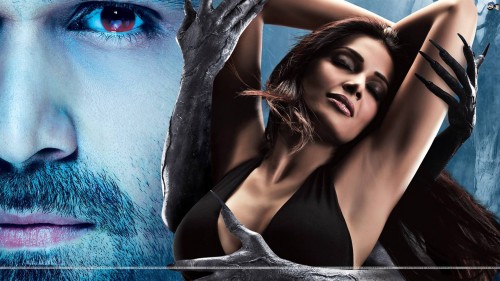 Mike McKenny, (@DestroyApathy) gives his thoughts on the 3D Bollywood horror film Raaz 3: The Third Dimension
Mike McKenny, (@DestroyApathy) gives his thoughts on the 3D Bollywood horror film Raaz 3: The Third Dimension
As no authority on the subject, but an avid film fan eager address a hole in my film knowledge, I have been taking regular trips to Cineworld Bradford to soak in the latest offerings that the glitz and glamour of Bollywood have to offer. Well, further to satisfying my own curiosity, as manager of the The Plaza Cinema, coming soon to Bradford, I feel it’s my duty to become more knowledgeable of this exuberant national cinema in order to see what’s hot and what’s not, and offer the best that it has to offer as part of our film programme.
This week’s viewing took the form of 3D horror/romance Raaz 3, written by Shagufta Rafique and directed by Vikram Bhatt. I don’t want to simplistically rely on comparisons to Hollywood, but some level of comparison is helpful to both a tourist in the field such as myself and to the majority of this readership, so let’s get it out of the way. The two glaring differences – both to the benefit of Bollywood – is the length and the central significance of passion and romance. The established norm of lasting over two hours gives a genre piece such as this the chance to breath, to not rush through its acts as is the case in the ninety minute standard that would apply to such a mid-level Hollywood horror genre film. With respect to the romance, Hollywood tends to patch on a romantic angle for the sake of convention and to hopefully acquire two named stars for purposes of promotion. Not that these things aren’t convention in Bollywood; stars are pivotal and a romantic angle seems essential (from my limited viewings). But rather than being latched on to a premise, as is the case with most Hollywood genre cinema, in this Bollywood feature the premise is constructed around the relationships, which are ingrained in the fabric of the film and absolutely essential. What results is a more earnest chemistry between the male and female leads.
Comparisons aside, and to concentrate on the film for its own merits, Raaz 3 is brimming with revenge, jealousy and self-recognition as an aging Bollywood star Shanaya, played with a captivating and convincingly chilling cold determination by Bipashu Basu, obsessed with the retention of her status as a ‘star’ in the face of the challenge offered by younger up-and-comers, disregards her god that has failed to head her prayers and is seduced into approaching a black magic practitioner to satisfy her needs. These needs are essentially the public psychological ruin of the actress who has taken her place as the star of the moment, Sanjana (Esha Gupta). Needing to get Sanjana to consume some cursed water, but needing a trusted source to give it to her, as opposed to sneaked through a servant, Shanaya enlists the help of star director and secret lover Aditiya (Emraan Hashmi) whom she brought to such a position of stardom. As the romance between the angelic Sanjana and Aditiya develops, he begins to question this morally dubious act, as well as questioning his own selfish motivations. The results of this cursed water sends Sanjana into an increasing mental decline, conveniently acting as increasingly intense set-pieces of horror and suspense.
Within these set-pieces Bhatt really shows off his directorial flair. The scenes are wildly imaginative and have a tempo worthy of the film’s placing within the mainstream horror genre. Each scene is tense, with only some absurd digital effects in one scene letting it down – although this scene does make the best use of the film’s 3D (which is for the most part as pointless as most 3D). There is one particularly terrifying section which includes the always traumatizing use of a clown. Along with these set-pieces, the magnificent thunderous score completes the sure-footed confidence in the use of horror tropes. Not afraid to camp it up a little and play it suitably over the top, the result is very much akin to others that use genre elements with heightened but effective confidence, such as Sam Raimi – particularly the way he approached Drag me to Hell – and Pedro Almodovar – as evidenced in last year’s stylised suspense piece The Skin I Live In. This Almodovar reference is possibly brought my mind further through the striking beauty and mesmerizing sexual imminence that is prevalent in pretty much everybody throughout the film – apart from the scary maggot guy and the creepy clown of course.
The film brazenly sets out a vicious attack on a system within which it operates itself, the Bollywood film industry. Shanaya’s insatiable need for stardom is exacerbated by this system that the film unashamedly exposes as vindictive, heartless and materialistic. Aditiya himself has to overcome the selfishness and self-important status-seeking that the industry has imprinted upon him in order to see the error of his ways.
In an illustration that Lacanian psychoanalysis leaves no national horror cinema untouched, there is a significant reference to Shanaya’s neglect from her father sowing the seeds of this unquenchable thirst for glory and power. Further twists are revealed throughout the film, giving enough to justify its running time and maintaining a healthy pace, culminating in a thoroughly tense and well executed final act.
Any fan of suspense cinema, psychological thrillers or horror films would do well to check out Raaz 3, whilst it is in cinemas.
Mike is behind the soon-to-be restored Plaza Cinema in Bradford. Find more about the cinema and what they have coming up on their Facebook page or on Twitter @ThePlaza_BD7. He is also co-director of Minicine and runs his own Destroy Apathy blog